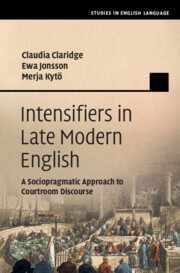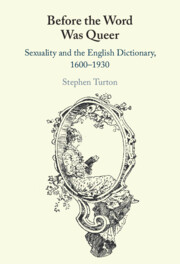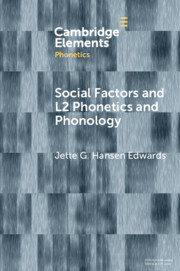110 results
26 - Sociolinguistic Variation in Slavic Languages
- from Part 5 - Sociolinguistic and Geographical Approaches
-
-
- Book:
- The Cambridge Handbook of Slavic Linguistics
- Published online:
- 16 May 2024
- Print publication:
- 23 May 2024, pp 559-583
-
- Chapter
- Export citation
A variationist study of /tʊt/ in Michif French
-
- Journal:
- Journal of French Language Studies , First View
- Published online by Cambridge University Press:
- 30 April 2024, pp. 1-23
-
- Article
-
- You have access
- Open access
- HTML
- Export citation
Chapter 3 - Dialect
-
- Book:
- Homer's Living Language
- Published online:
- 11 April 2024
- Print publication:
- 18 April 2024, pp 130-193
-
- Chapter
- Export citation
Chapter 12 - Conclusion
-
- Book:
- Intensifiers in Late Modern English
- Published online:
- 15 March 2024
- Print publication:
- 28 March 2024, pp 288-297
-
- Chapter
- Export citation
The embedded Wh- in situ clause: French tout court? Les spasmes musculaires incontrôlés, je sais pas c’est quoi (France Info 20/10/21)
-
- Journal:
- Journal of French Language Studies , First View
- Published online by Cambridge University Press:
- 27 March 2024, pp. 1-33
-
- Article
-
- You have access
- Open access
- HTML
- Export citation

Intensifiers in Late Modern English
- A Sociopragmatic Approach to Courtroom Discourse
-
- Published online:
- 15 March 2024
- Print publication:
- 28 March 2024

Before the Word Was Queer
- Sexuality and the English Dictionary, 1600–1930
-
- Published online:
- 14 March 2024
- Print publication:
- 21 March 2024
A social turn for Construction Grammar: double modals on British Twitter
-
- Journal:
- English Language & Linguistics , First View
- Published online by Cambridge University Press:
- 27 February 2024, pp. 1-29
-
- Article
-
- You have access
- Open access
- HTML
- Export citation

Social Factors and L2 Phonetics and Phonology
-
- Published online:
- 19 February 2024
- Print publication:
- 14 March 2024
-
- Element
- Export citation
6 - Conclusion
-
- Book:
- Language as Hope
- Published online:
- 11 January 2024
- Print publication:
- 01 February 2024, pp 153-161
-
- Chapter
-
- You have access
- Open access
- HTML
- Export citation
5 - Scaling Hope
-
- Book:
- Language as Hope
- Published online:
- 11 January 2024
- Print publication:
- 01 February 2024, pp 123-152
-
- Chapter
-
- You have access
- Open access
- HTML
- Export citation
I - Introduction
-
- Book:
- Language as Hope
- Published online:
- 11 January 2024
- Print publication:
- 01 February 2024, pp 1-20
-
- Chapter
-
- You have access
- Open access
- HTML
- Export citation
1 - Language as Hope
-
- Book:
- Language as Hope
- Published online:
- 11 January 2024
- Print publication:
- 01 February 2024, pp 21-47
-
- Chapter
-
- You have access
- Open access
- HTML
- Export citation
3 - Hope in the Present
-
- Book:
- Language as Hope
- Published online:
- 11 January 2024
- Print publication:
- 01 February 2024, pp 79-101
-
- Chapter
-
- You have access
- Open access
- HTML
- Export citation
2 - “País do Futuro” and Present-Day Communities of Hope
-
- Book:
- Language as Hope
- Published online:
- 11 January 2024
- Print publication:
- 01 February 2024, pp 48-78
-
- Chapter
-
- You have access
- Open access
- HTML
- Export citation
4 - The Enregisterment of Hope
-
- Book:
- Language as Hope
- Published online:
- 11 January 2024
- Print publication:
- 01 February 2024, pp 102-122
-
- Chapter
-
- You have access
- Open access
- HTML
- Export citation
Chapter 11 - Latin Literature and Linguistics
-
-
- Book:
- The Cambridge Critical Guide to Latin Literature
- Published online:
- 04 January 2024
- Print publication:
- 18 January 2024, pp 563-612
-
- Chapter
- Export citation
Introduction
-
- Book:
- Making English Official
- Published online:
- 04 January 2024
- Print publication:
- 18 January 2024, pp 1-28
-
- Chapter
- Export citation
Empires, Languages, and Scripts in the Perso-Indian World
-
- Journal:
- Comparative Studies in Society and History / Volume 66 / Issue 2 / April 2024
- Published online by Cambridge University Press:
- 11 January 2024, pp. 443-469
-
- Article
-
- You have access
- Open access
- HTML
- Export citation

Language as Hope
-
- Published online:
- 11 January 2024
- Print publication:
- 01 February 2024
-
- Book
-
- You have access
- Open access
- Export citation



